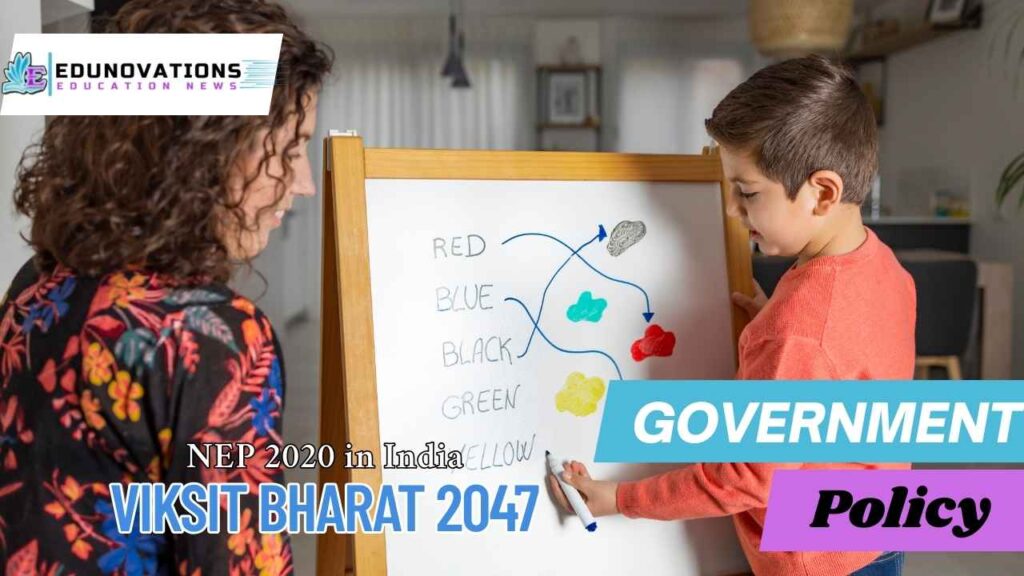Transforming India’s Future: Revolutionary Steps in integrated early childhood care education for a Viksit Bharat 2047
Introduction of integrated early childhood care education Reforms
In a major stride toward building a stronger, more inclusive future, government authorities are overhauling India’s early childhood education framework in line with the visionary National Education Policy (NEP) 2020. This transformative initiative aims to integrate an expansive Early Childhood Care Education (ECCE) module into the mainstream school education system, fundamentally restructuring the pedagogical process for children aged 3 to 8 years. With a focus on play-based learning, holistic development, and a seamless transition into primary education, these reforms are laying the foundation for a Viksit Bharat 2047—a developed and progressive India.
This breakthrough in educational policy is not just a bureaucratic reorganization but a concerted effort to boost the social and human capital of the nation. By bridging the gap between early childhood development centers and formal schooling, the revised structure promises enhanced learning outcomes, better social-emotional support, and improved foundational literacy and numeracy for every child.
A Vision for Holistic Child Development
The NEP 2020 Framework and ECCE (integrated early childhood care education )Integration
At the heart of these reforms lies the National Education Policy 2020, which advocates a radical shift from the traditional 10+2 system to a more inclusive 5+3+3+4 structure that spans from ages 3 to 18. This new framework is designed to integrate early childhood care into the formal education system, ensuring children receive targeted, age-appropriate education from as early as three years old.
The key aspects of this visionary framework include:
- Foundational Stage Emphasis: The initial five years (3-8 years) are reimagined as the foundational stage. This stage comprises three years of pre-school education for children aged 3 to 6, followed by two years of early primary education (Grades 1 and 2).
- Play-Based Learning: Recognizing the critical importance of play in cognitive and social development, the policy strongly advocates for play-based educational methodologies.
- Joint Oversight: ECCE implementation is a collaborative venture involving multiple ministries—the Ministries of Education, Women & Child Development (WCD), Health and Family Welfare (HFW), and Tribal Affairs—ensuring cohesive policy execution and resource utilization.
- Seamless Transition: The newly designed educational structure aims to bridge early childhood education centers with formal schools to create a continuous learning experience that nurtures a child’s overall well-being and academic preparedness.
Government Initiatives and Collaborative Actions
In a detailed memorandum directed to Chief Secretaries and Administrators, top officials from the Department of School Education & Literacy and the Ministry of Women & Child Development outlined key strategies to ensure the effective integration of ECCE (integrated early childhood care education ) within school infrastructure. These strategies include:
- Mapping and Co-Location: A systematic approach to map all existing Anganwadis (government-supported child care centers) and align them with nearby schools. This co-location strategy not only improves early learning outcomes but also facilitates a smoother admission process for children entering Grade 1.
- Focus on Rural and Remote Areas: Special measures are in place to bolster ECCE in rural, remote, and tribal regions. By strengthening the linkages between Anganwadis and primary schools, the reforms seek to address regional disparities in educational quality.
- Infrastructure Optimization: The feasibility of integrating Anganwadis with existing school facilities is under continuous review. Facilities in rented or makeshift buildings are being assessed for potential conversion into permanent ECCE centers.
- Capacity Building for Educators: Recognizing the pivotal role of teachers, the initiative calls for joint training programs that enhance the pedagogical skills of Anganwadi workers and pre-primary teachers. Collaborations with NCERT, SCERTs, DIETs, and NIPCCD are set to standardize and elevate early childhood teaching methodologies.
- Resource Enhancement: The innovative use of educational tools such as tactile teaching learning materials (e.g., Jaadui Pitara, e-Jaadui Pitara) and pre-school education kits aims to enrich the learning environment and promote interactive, play-based learning experiences.
Impacting Education: Policy, Practice, and Promising Outcomes
Bridging the Gap Between Policy and Practice
This multifaceted reform strategy is designed to translate policy objectives into tangible outcomes at the grassroots level. The following actions highlight the comprehensive approach being undertaken:
- Enhanced Data Sharing: To streamline monitoring and implementation, both the Ministry of Education and Ministry of WCD are working towards establishing an integrated data-sharing mechanism. This includes the adoption of a common unique ID—such as the APAAR ID—that will track a child’s educational journey from ECCE (integrated early childhood care education )through to higher education.
- Coordinated Field Operations: Efforts to foster closer collaboration between school education departments and local WCD units are underway. This coordination will help overcome operational challenges in the co-location of Anganwadis with schools, ensuring that services in education, health, and nutrition are delivered seamlessly.
- Special Programs and Collaborative Events: Joint initiatives like ECCE Days, Annual Days, and Poshan Maah are being planned to build a community-centric approach to early childhood development. These events not only promote a shared vision but also strengthen the collaborative engagement of stakeholders at all levels.

The Broader Vision: Building a Viksit Bharat 2047
The reimagined integrated early childhood care education framework is more than an educational reform; it is a catalyst for social transformation. By enhancing early education, the initiative aims to cultivate a generation that is not only academically proficient but also emotionally resilient and socially responsible. In a broader economic context, the improved early education outcomes are expected to contribute to the nation’s human capital development—vital for India’s progress toward becoming a developed nation by 2047.
Recent studies have consistently demonstrated that quality early childhood education leads to significant long-term benefits, including:
- A 20-40% increase in school readiness,
- Improved performance in later academic years, and
- Enhanced social skills that translate into a more productive workforce.
These statistics underscore the transformative potential of a robust integrated early childhood care education framework and reinforce the importance of a collaborative, integrated approach to early education policy.
International Perspectives and Expert Insights
Global Trends in Early Childhood Education
India is not alone in this educational overhaul. Globally, several countries have embraced integrated early childhood care education reforms with remarkable success. Nordic nations, for example, have long recognized the importance of play-based and child-centered learning, resulting in some of the highest educational outcomes in the world. These international examples provide valuable lessons in implementing similar policies in India, where diversity and scale present unique challenges.
Expert Opinions on integrated early childhood care education Reforms
Leading educators and policymakers have lauded the integrated approach as a groundbreaking step toward a more equitable educational system. Dr. Meena Sharma, an expert in early childhood pedagogy, emphasizes,
“By aligning early learning with formal education, we are creating a robust foundation that not only improves academic outcomes but also nurtures critical life skills. This reform is a vital investment in our future.”
Experts also point out that a well-implemented integrated early childhood care education policy can significantly reduce dropout rates and bridge the urban-rural educational divide. With the support of modern technology and data-sharing mechanisms, these reforms are expected to deliver measurable improvements in student performance and overall child development.
Collaborative Synergies
The envisioned reforms foster cross-sector collaboration that leverages insights from education, health, nutrition, and social services. Such synergies are vital for the holistic development of children, ensuring that every facet of their growth is addressed in a cohesive manner. The involvement of various government bodies and their adherence to international best practices underscore India’s commitment to a comprehensive education system that is both modern and inclusive.
Internal Links and resources
To provide readers with additional context and resources, this article is interwoven with carefully chosen internal and external links. Internal links direct readers to valuable educational resources such as:
- NCERT Courses,
- Current Affairs,
- Notes,
- MCQs,
- Videos,
- Syllabus Details,
- Downloads of Free NCERT PDFs, and
- NCERT Mind Maps.
For institutions seeking innovative educational solutions, an external resource is available at Need Website for Schools Contact. These links not only enhance the reader’s experience but also reinforce the credibility and interconnectedness of the educational ecosystem.
The Future of Early Childhood Education in India
Scaling the Reforms
The implementation of these initiatives will take a phased approach, with pilot projects in select states followed by broader national rollout. Key priorities include:
- Expanding Infrastructure: Upgrading existing Anganwadis and school facilities to support integrated early childhood care education centers.
- Standardization of Curriculum: Developing standardized, play-based learning modules that can be adapted across various regions.
- Capacity Building: Intensive training programs for educators to ensure smooth adaptation to the new pedagogy.
- Stakeholder Engagement: Continuous feedback loops with parents, teachers, and community leaders to fine-tune the policies based on ground realities.
Monitoring and Evaluation
Robust monitoring and evaluation mechanisms will be put in place to measure progress and ensure accountability. The planned data-sharing approach, with a common unique identifier for every child, will enable seamless tracking of educational outcomes from early childhood through higher education. This comprehensive monitoring will facilitate prompt corrective measures, ensuring the reforms deliver on their promise of holistic child development.
Projected Long-Term Benefits of integrated early childhood care education Reforms
The long-term benefits of these reforms are manifold:
- Improved Educational Outcomes: Early intervention will lay the groundwork for higher academic achievement.
- Economic Growth: A well-educated workforce contributes significantly to national productivity and innovation.
- Social Equity: Universal access to quality education will bridge disparities, fostering social cohesion and upward mobility.
Statistical forecasts indicate that investments in early education can yield economic returns of up to 13% per annum, making this initiative both a social and economic imperative.
FAQs
1. What is the recent reform in India’s early childhood education?
The reform integrates Early Childhood Care and Education into the mainstream school system under the NEP 2020, focusing on a play-based, holistic development approach for children aged 3 to 8 years.
2. How does the new 5+3+3+4 education structure work?
This structure covers ages 3-18, with the first five years (3-8 years) serving as the foundational stage, including three years of preschool and two years of early primary education.
3. What is the significance of co-locating Anganwadis with schools?
Co-location facilitates a smoother transition between early childhood education and formal schooling, ensuring continuous, holistic development and better admission processes.
4. How will the reforms address challenges in rural and remote areas?
Special measures, including improved infrastructure and stronger linkages between Anganwadis and primary schools, will target these regions to reduce educational disparities.
5. What role does play-based learning have in the new policy?
Play-based learning is essential for fostering cognitive, social, and emotional development in young children, making education engaging and effective.
6. How are the ministries collaborating on this initiative?
The Ministry of Education, Women & Child Development, along with Health, Family Welfare, and Tribal Affairs, are jointly overseeing the integration of ECCE with school education.
7. What are some key strategies to support this policy?
Strategies include mapping Anganwadis with nearby schools, capacity building for educators, streamlined data sharing, and focused programs for rural and tribal areas.
8. How will the reforms impact long-term economic growth?
By improving educational outcomes and developing a skilled workforce, the reforms are expected to boost national productivity and contribute to sustained economic growth.
9. What monitoring mechanisms are in place?
A unified data-sharing system using a common unique identifier will track children’s educational progress and facilitate real-time monitoring and evaluation.
10. Where can stakeholders find more information about these reforms?
Additional information is available through various educational resources, including NCERT Courses, Current Affairs, and Need Website for Schools Contact.
Conclusion for integrated early childhood care education Reforms
In conclusion, India’s revolutionary approach to early childhood education reform is poised to reshape the future of learning for millions of children. By integrating robust pedagogical practices, comprehensive infrastructure, and collaborative government initiatives, the reform not only aligns with global best practices but also paves the way for a more equitable and dynamic society. As the nation marches toward Viksit Bharat 2047, these transformative changes in early education will serve as the cornerstone of a prosperous and progressive future.









